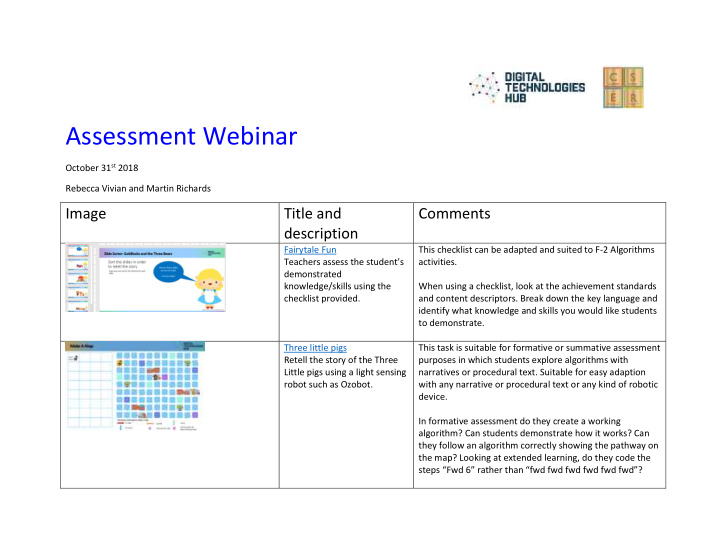



Assessment Webinar October 31 st 2018 Rebecca Vivian and Martin Richards Image Title and Comments description Fairytale Fun This checklist can be adapted and suited to F-2 Algorithms Teachers assess the student’s activities. demonstrated knowledge/skills using the When using a checklist, look at the achievement standards checklist provided. and content descriptors. Break down the key language and identify what knowledge and skills you would like students to demonstrate. Three little pigs This task is suitable for formative or summative assessment Retell the story of the Three purposes in which students explore algorithms with Little pigs using a light sensing narratives or procedural text. Suitable for easy adaption robot such as Ozobot. with any narrative or procedural text or any kind of robotic device. In formative assessment do they create a working algorithm? Can students demonstrate how it works? Can they follow an algorithm correctly showing the pathway on the map? Looking at extended learning, do they code the steps “Fwd 6” rather than “fwd fwd fwd fwd fwd fwd”?
Sample assessment activities: Problem-based learning activities in which a process or Programming or procedure is required to solve the problem. Computational Thinking EXAMPLE: Get from start to finish with aim of highest activities (plugged and points score. Can be a game to land on squares and add unplugged activities). points Questions for consideration: Can they explain their game and how to get from start to finish? How do they describe movement and directions? Do they use arrows or steps, right or left? Lunch box data Years 3-4 Use this assessment task to Provides a checklist to assist with assessment. explore data collection, analysis and presentation. Pixels and binary digits Years 5-6 and Years 7-8 (discover what they know) Students are given a bitmap You could provide the assessment task regardless of image made up of coloured students experience with 3-bit binary. Refer to this site to pixels. They explain how the explore and have a play and come back to the assessment image is made up of binary task https://studio.code.org/s/pixelation/stage/3/puzzle/1 digits that represent each pixel. Students represent 8 Yrs 7-8 would focus on more complex binary numbers and colours using binary digits. 24-bit colour (made up of 3 x 8 bit binary digits). Teachers assess the student’s demonstrated knowledge/skills using the checklist provided.
PDF of solo taxonomy You can use the solo taxonomy to help differentiate the task and help students progress from one stage to the next. Customise to create your own rubrics with your students’ input. Try creating your own SOLO Taxonomy Rubric, based on the achievement standard text, on the HookED website! http://pamhook.com/solo-apps/functioning-knowledge- rubric-generator/ BBC micro:bit project Years 5-6 (can be adapted and modified for Yrs 3-4 or Yrs 7- Students maintain a project 8) log as evidence towards their Summative assessment work on creating a digital Collect four pieces of evidence to assess students on this solution using the BBC: task. micro:bit. The teacher 1. Design assesses the student’s o Students provide a document of their knowledge and skills using the design that they created before student’s project log, self - implementing their digital solution. reflection and think aloud. 2. Project log o Students provide their completed project Includes a rubric which can be log and use it to discuss how they modified. For example you progressed on the project and how could add programming focus effectively they used their time. such as have the students 3. Self-reflection included user input, branching o Ask students to use the Self- and repetition (and are able to reflection handout to self-assess explain these). themselves against the rubric supplied. 4. Think aloud o Ask students to create a brief presentation ‘think aloud’ that explains how they designed and created their digital solution.
Whole school approach to Years 5-6 coding (check out this resource for whole school This assessment can be adapted for other robotics approach ideas) technology, not just Lego EV3. Year 5 EV3 robotics sample assessment SOLO Taxonomy robotics Years 7-8 This can be used as a guide Use a project based approach to assess students as they but depends on your project complete tasks that are self-chosen. focus. Create rubrics negotiated with students. Asse ssing students’ work in robotics In this short video, Dr Ethan Danahy talks through his assessment approach for a unit where students design and create a robotic animal in teams. This could be useful for teachers who are seeking ideas for designing assessment around robotics projects, including assessment characteristics.
ScratchJr: Assessment Years F-4 ScratchJr Assessments is a Assess students’ understanding of programming concepts resource to assess students’ using block puzzles. understanding of the programming blocks in the For consideration: Can students identify the correct ScratchJr iPad app. output? Extension: Can students create their own algorithm puzzles for peers?
Digital Systems Years 5-6 Students create a concept map or mind map that Concept mapping could be used for a variety of topics. This demonstrates what they know could even be undertaken at the beginning of a unit of about digital systems, how instruction and at the end to compare student changes in different components are learning. connected and the role they play, using the school network as an example. Search lesson ideas All DT Hub lesson ideas have assessment advice Click on the “Assessment” button.
Recommend
More recommend